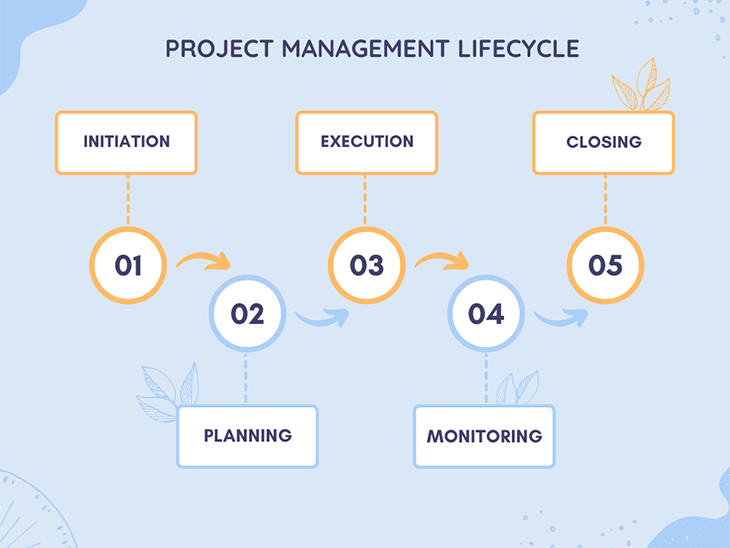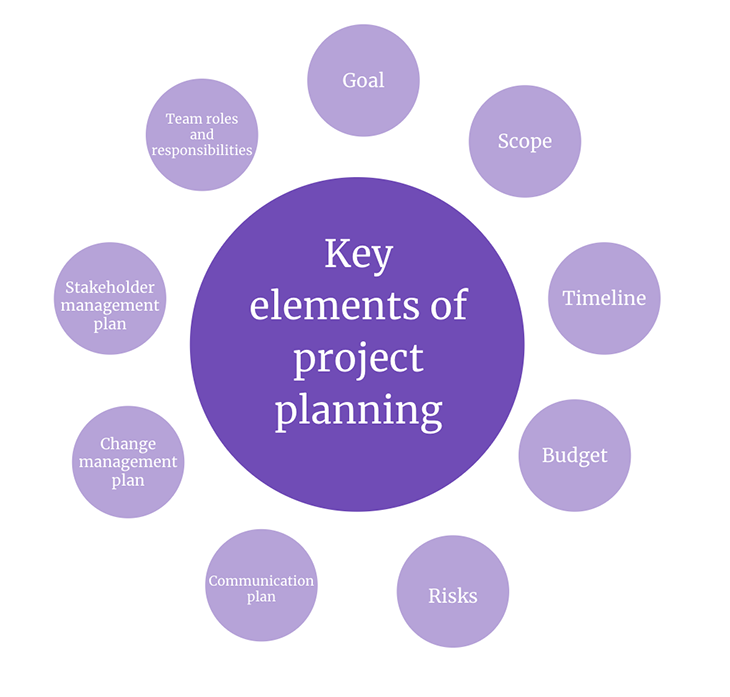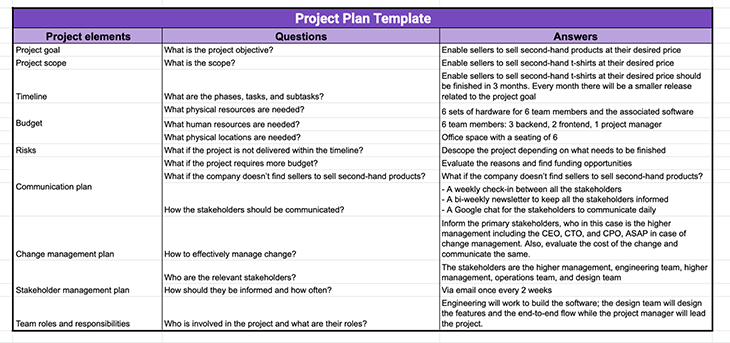“Hi, Aniket, good to see you again!” My manager greeted me after I came back from my two-month annual vacation to India. Back then, I was working as a product manager at Zalando, one of Europe’s biggest fashion e-commerce companies.

After coming back, I asked my manager if she knew what I would be working on next. We had a one-hour meeting and I learned that I’d be leading one of the most complex products — a completely new version of our in-house content management system. I was elated, to say the least.
At the end of the day, I was assigned the task of coming up with a rough project plan for this product. Even though I had worked on creating multiple project plans back then, I was nervous. This product was complicated and had hundreds of use cases. I didn’t know where to start. This was the first taste of building a project plan for a highly complex product.
In this blog, we’ll cover the importance of project planning and its key elements. We’ll look at a project plan template, walk through a realistic example, and cover tips for efficient project planning in your organization. Let’s get started!
Before we get into project planning, it’s important to understand the lifecycle of a project:

Since we are focusing on project planning, we’ll deep-dive into its different elements. However, to do that, we first need to understand why project planning is important.
The project that I was given to lead at Zalando was a highly complex one. The estimated timeline for completing the project was one year — this is fairly high in the software development world.
There were three engineering teams involved each with 7–8 team members. When it comes to complex projects, it’s essential to have a strong project plan in place.
Here are a few reasons why project planning is important:
As they say “without a goal, you can’t score.”
Every project needs a goal or outcome for the team to understand what they are supposed to do. Project planning helps achieve that.
Initial project planning helps to understand how much estimated time the team will take and how much money the project requires. The latter includes salaries of employees, hardware costs, training, etc.
This is an extremely important part of a project plan. Project planning helps identify potential blockers or risks, thereby enabling the project manager and teams to create a risk mitigation strategy.
A strong project plan helps everyone understand their responsibilities. This, in turn, helps the teams collaborate effectively and finish the project within the timeframe.
Next, let’s review the key elements of project planning:

This is pretty self-explanatory, it’s what the project is going to hopefully achieve by the end. It’s important to have SMART goals so they’re as specific and unambiguous as possible.
This is the very first element of a project plan that the team decides on. Scope helps the teams understand what they need to achieve and gives direction to the product. Scope typically includes objectives, goals, expected deliveries, and project limitations.
This helps teams understand when they need to deliver the project and how to divide the project into small, executable milestones that fit into the total timeline. It also includes the allocation of resources, personnel equipment, and necessary training.
The budget details the financial part of the project. Questions like how much total money needs to be spent to finish the project, what are the funding sources, what are the revenue projects, etc. are answered via budgeting. This also includes the salaries of team members, training costs, equipment costs, etc.
Every project comes with its own risks. Risks are factors that could impact the project’s successful completion. These could be the availability of resources, legal and/or regulatory compliance, or technology limitations.
Assessing risks early on helps detail how they can be mitigated to successfully deliver the project. One point to note is that it’s not possible to identify all the risks early on. For example, no companies could predict the magnitude of the outbreak of COVID-19. This proves that some risks are beyond the control of the company and teams.
A project requires effective collaboration between different team members, such as designers, engineers, marketers, sales personnel, etc. To achieve this, a project needs to have a strong communication plan. This includes meeting schedules, modes of communication, and reporting requirements.
As mentioned in the risks section, there are times when the project needs to change because of unidentified or unplanned risks. These changes might affect the scope, timeline, budget, resources, or any other part of a project.
This is why a change management plan needs to be discussed. This plan outlines how a project can be changed, how to communicate changes to stakeholders, and how to address concerns or conflicts.
Every project has stakeholders. Stakeholders can either play an active role in finishing projects, such as engineering and designers, or simply may just be interested in the status of the project, such as higher management.
Having a stakeholder management plan will keep the stakeholders educated and engaged, thereby removing any blockers or concerns.
As mentioned earlier, a project requires active collaboration between different teams and team members. This is why a clear definition of who will work on what is extremely important. It also helps to outline the responsibilities of every team member, project manager, project sponsor, etc.

Here is a free project plan template that I created. Feel free to use it at your convenience. This highlights all the points that are mentioned above in the key elements of the project planning section.
You can make a copy of this template to customize for your projects by going to File > Make a copy.
Let’s go through an example to create a project plan using the above template.
We’ll start with the project goal. As mentioned earlier, the first part of a project plan is to understand the needs of the project. The outcome of this is to have a specific goal and outcome. This is the most critical part since it will drive the entire project.
For example, let’s say we work for an established e-commerce company that’s doing well in selling fashion products and we’ve already identified a need of selling second-hand products. In this case, the goal is to “enable sellers to sell second-hand products at their desired price.”
Once the goal is identified, the next step is to define the scope. This helps to deliver results faster. Here’s an example: to enable sellers to sell second-hand products at their desired price on an e-commerce shop, we need to: enable a new categorization “second-hand” on the website for the users to discover; build systems to enable sellers to sell the second product at their desired rates; and define return and exchange policies.
These are just a few of the things that the team will need to work on. And hence, it’s important to scope the project so that it’s easier for the team to deliver. For example, enable sellers to sell second-hand t-shirts at their desired price. This will help the team only focus on one category as compared to tens of other categories, thereby having a clear scope to work on.
Next, we have timeline. As mentioned previously, this helps the team know how soon they need to deliver the project. For our example, we could say that our goal to enable sellers to sell second-hand t-shirts at their desired price should be finished in three months. Every month, there will be a smaller release related to the project goal.
Next up is the budget. This falls in the bucket of the sponsor. Usually, that’s someone from higher management. We need to know what physical resources, human resources, and physical locations are necessary
For example:
Risks are an extremely critical part of a project that helps identify potential risks early on and create a contingency plan. We can ask ourselves things like, “What if the project is not delivered within the timeline?” “What if the project requires more budget?” or “What if the company doesn’t find sellers to sell second-hand products?”
For the first question, we could de-scope the project depending on what needs to be finished. For the second, evaluate the reasons and find funding opportunities, And for the third question, we could understand the reasoning and iterate the product (or close it, depending on the feedback).
This is the backbone of the project and keeps the project audience together.
Here’s an example of a communication plan:
Questions such as “What happens if something goes wrong?” are taken care of in this section.
Inform the primary stakeholders, who, in this case, are higher management (including the CEO, CTO, and CPO) ASAP in case of changes. Also, evaluate the cost of the change and communicate the same.
This part talks about who are the relevant stakeholders, how should they be informed, and how often. In this case, the stakeholders are the higher management, engineering team, operations team, and design team. They should be informed via email once every two weeks.
Lastly, every project requires active collaboration between different teams. And hence why it’s necessary to understand who is involved in the project and what their roles are.
For example, engineering will work to build the software, the design team will design the features and the end-to-end flow, and the project manager will lead the project.
Here is the template with all the filled answers.

The following are some lessons learned and advice I’d give for effective project planning:
A good project plan can help the team sail the winds smoothly. It forms the backbone of the project. A project plan can give clear visibility to all stakeholders, thereby helping everyone accomplish the desired goal.
Featured image source: IconScout

LogRocket identifies friction points in the user experience so you can make informed decisions about product and design changes that must happen to hit your goals.
With LogRocket, you can understand the scope of the issues affecting your product and prioritize the changes that need to be made. LogRocket simplifies workflows by allowing Engineering, Product, UX, and Design teams to work from the same data as you, eliminating any confusion about what needs to be done.
Get your teams on the same page — try LogRocket today.

Most teams fail at autonomy. Learn how clear rules help product teams move faster without micromanagement.

A practical framework for PMs to use AI in ideation without sacrificing judgment, strategy, or decision quality.

A practical five minute revenue estimation method to help product managers compare ideas, drop low impact features, and prioritize smarter.

A practical guide for PMs who want to stop being bottlenecks, delegate smarter, and lead teams effectively with a clear ownership framework.
One Reply to "A guide to project planning (with template and examples)"
Thanks a lot for your hard work and great samples! Really appreciate. I think project planning also requires digital tools for planning. Kanbantool.com seems to be a great match here. I bet you have heard about kanban 🙂 Thanks once again and wish you luck, and all smooth i professional life 🙂